Network Rail
Network Rail’s management maturity (RM3)
The use of our updated inspection application allowed us to gather a more detailed picture of Network Rail’s performance from nearly 300 interventions, including inspections, investigations, and statutory activities.
Although Network Rail operates as a single legal entity, operational practices often reflect a more devolved structure. This variability can impact the consistency and effectiveness of the safety management system. A more integrated approach, supported by consistent leadership focus, would help ensure that centrally developed standards are effectively applied across all regions. Consistent assurance across the business remains an area for development.
Overall, Network Rail continues to operate at a ‘standardised’ level of management maturity.
Risk performance
In 2024 to 2025, 29 high-potential train accident incidents were reported, a slight decrease from 33 the previous year (source: Network Rail). As in previous years, level crossings accounted for the majority of incidents. The most serious involved a head-on collision at Talerddig, resulting in one passenger fatality and multiple injuries.
Figure 1: Precursor Indicator Model (PIM)
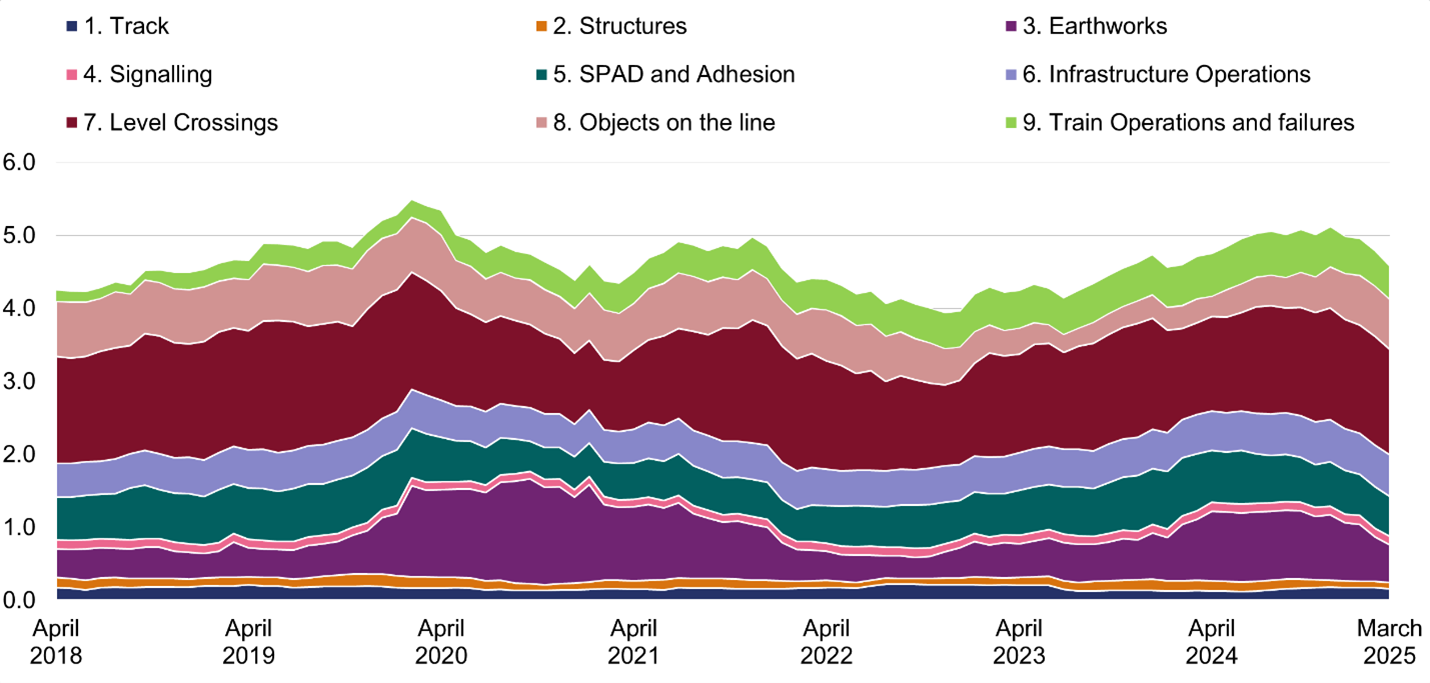
Source: RSSB
Following level crossings, earthworks events – often driven by adverse weather – were a major contributor to Fatalities and Weighted Injuries (FWI), particularly in autumn. Risks associated with Signals Passed at Danger and adhesion-related incidents have declined.
Workforce safety incidents remained stable overall, with 29 high-potential events recorded. The leading causes continued to be slips, trips, and falls. Precursor risk trends are broadly unchanged from the previous year.
Control Period 7 (CP7) health and safety delivery plan
CP7 began in April 2024 and sets out 17 key themes to improve health and safety performance through to March 2029. We introduced internal dedicated monitoring resource to support delivery and maintain momentum.
We observed that Network Rail has not fully embedded the Safety Risk Bowtie framework in its risk assessments - particularly in areas where asset renewal activity is being reduced. This tool is central to understanding how such changes might affect risk. To strengthen delivery, we are encouraging greater consistency between regions, clearer governance arrangements, and better visibility of cross-cutting safety themes.
Extreme weather
Extreme weather events in particular, and their impact on buildings and structures management, have continued to be a significant issue for the industry. As part of our multi-year strategic intervention programme, we undertook several observations of regional extreme weather preparation meetings in the run-up to named storms and warnings. This allowed us to assess whether Network Rail’s current standard had been met and is sufficient to achieve the level of control required. We completed this year’s interventions by carrying out regional assurance audits of Network Rail’s arrangements, with the aim of developing a national picture of compliance within the requirements of health and safety law.
Asset safety
This year we undertook work with Network Rail centrally and in the regions on three key areas of asset safety:
Structures and operational property
With responsibility for over 30,000 structural assets and 2,500 stations, Network Rail’s examination and assessment regime is critical to infrastructure safety. Our inspections identified regional shortfalls in compliance with asset management standards, affecting around 4,500 structures and stations. Network Rail confirmed in February 2025 that risk assessments are now in place for all previously non-compliant structures and that station assessments were completed by April 2025. We will continue to monitor progress as this programme advances.
Earthworks and drainage
Two high-potential earthworks events occurred during the year, though timely mitigations prevented derailments. Encouragingly, the rate of high-consequence failures decreased compared to 2023 to 2024. We continue to focus on Network Rail’s ability to manage drainage assets effectively and expect that asset identification and record-keeping are maintained to a high standard.
Track and lineside
A freight train derailment in Audenshaw in September 2024 caused significant infrastructure damage, although there were fortunately no injuries. Our investigation identified shortcomings in track maintenance practices, leading to the issuing of an Improvement Notice for the Manchester Delivery Unit in April 2025 (This notice was served outside the reporting period for this report, so is not included in the notice information in our key enforcement activities later on in this report). Network Rail has since initiated a detailed action plan, and we will work closely with them to ensure actions are delivered and lessons are embedded across the organisation.
Modernising maintenance (MM)
Modernising Maintenance remains a key area of change for Network Rail’s Delivery Units. While some units have adapted well, others face challenges in balancing resources, access, and proactive maintenance. Although Switches and Crossings (S&C) inspection standards are being met, there are signs of operational strain, including inspection backlogs and temporary workarounds. We continue to encourage a robust safety management system that prevents such measures from becoming standard practice.
Trackworker safety
Since a series of tragic incidents between 2019 and 2021, Network Rail has made good progress in reducing red zone working with unassisted lookout protection. While technologies like the Semi-Automatic Track Warning System (SATWS) are available, uptake has been slower than expected. However, we are seeing more work conducted under protective conditions such as line blockages and night-time possessions. Near-miss incidents involving trackworkers have fallen significantly – from 65 to 16 annually – reflecting the positive impact of the Track Worker Safety Task Force. Network Rail is now exploring risks arising from possession and line blockage irregularities.
Electrical safety
The Electrical Safety Delivery Programme, which includes the rollout of the Traction Power Centralised Management System (TPCMS), has experienced further delays. This programme aims to modernise safety systems and reduce staff exposure to operational hazards. We continue to review progress closely and support efforts to improve efficiency and reduce risk through automation.
Level crossings
In 2024 to 2025, five fatalities occurred at level crossings, primarily at passive footpath crossings where users must rely on their own judgment to cross safely. This compares to one fatality in 2023 to 2024 and five in 2022 to 2023. Usage of footpath crossings has remained elevated since the pandemic, and near-miss incidents have also increased. In 2025 to 2026, we will conduct a series of inspections across all Network Rail regions to assess how effectively risk is being managed at these crossings.
Occupational health
Network Rail’s Occupational Health team continues to lead a positive shift in the organisation’s approach to health risks. A new health strategy is being delivered, and a maturity model is planned for implementation in 2026. Our engagement this year focused on ensuring strategic alignment with legal duties and promoting consistency across routes and regions. We continued our focus on the health impacts of exposure to welding fumes and our interventions have allowed us to gather insights on Network Rail’s progress in controlling these risks. Inspections next year will assess compliance with the use of appropriate risk controls and our findings will be used to generate specific region and route reports, informing a national overview.
Human factors
We continue to monitor how human factors are being addressed by Network Rail and its suppliers. Challenges in this area contributed to delays in the European Train Control System (ETCS) upgrade on the Northern City Line. Strengthening supplier engagement, improving resources, and fostering a more proactive approach will be important to ensure that human factors are effectively considered in future projects.
Fatigue
Our updated guidance on Managing Rail Staff Fatigue, published in August 2024, received a positive industry response. Early inspections suggest that the guidance is helping improve fatigue management systems, though additional progress is needed in training, monitoring, and the use of meaningful performance indicators.
We have raised concerns about Network Rail’s proposed changes to fatigue standards. As a result, implementation has been paused to allow for further data gathering and review. We remain closely engaged with the Fatigue Improvement Programme and continue to support the development of a long-term, sustainable approach to fatigue risk.
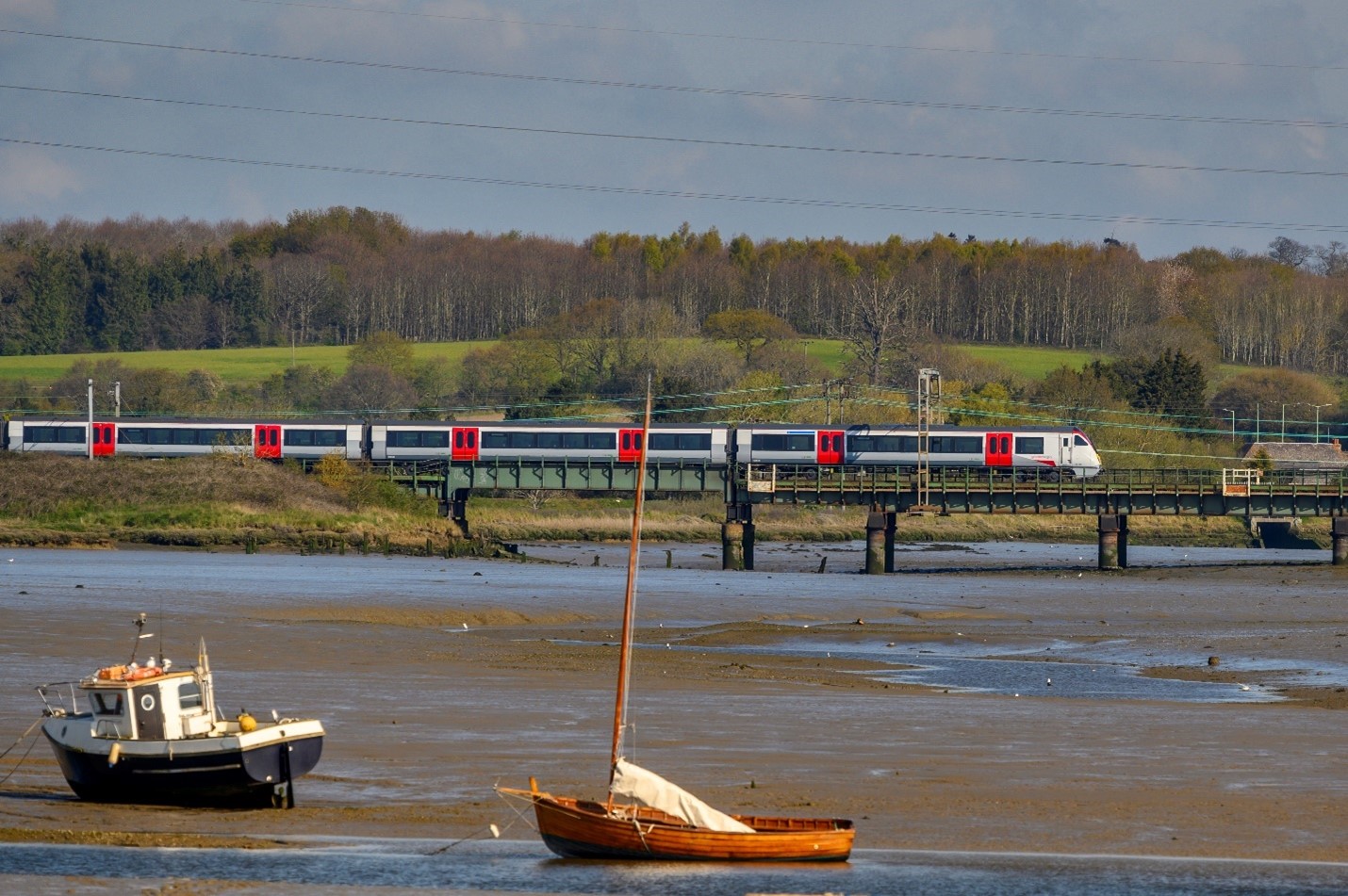
Mainline train operators and freight
The mainline operators comprise charter operators, passenger train operators (TOCs) and freight operating companies (FOCs) that operate over infrastructure controlled by Network Rail and Amey Infrastructure Wales Limited (Seilwaith Amey Cymru).
Rail reform context
As franchised mainline passenger operators transition into public ownership, we have observed positive and enhanced collaboration with Network Rail. A notable example is the strategic integration between Southeastern and Network Rail with a single leadership team, which has helped to streamline functions in preparation for the formation of Great British Railways.
We will continue to monitor the safety implications of reform, supporting alignment between operator safety management systems and infrastructure integration. We will maintain direct engagement with operators to promote shared learning and best practice across the industry.
Signals Passed at Danger
Following the conclusion of our three-year SPAD inspection programme in 2024, we have continued to monitor trends across passenger and freight operators. Although total SPAD numbers show a slight increase, high-risk SPADs have remained broadly consistent over the past four years.
Figure 2: Signals Passed at Danger on the Mainline
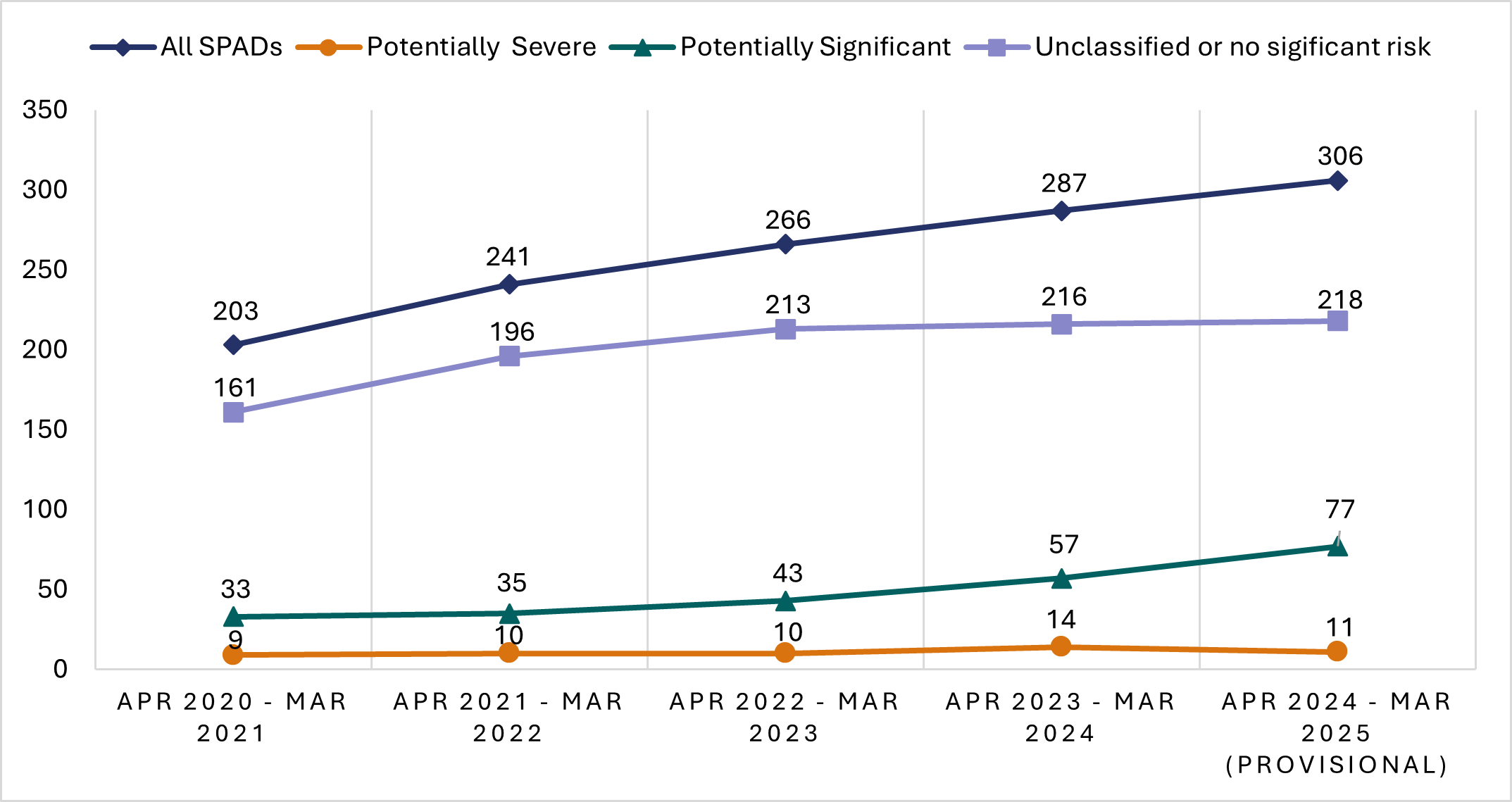
Source: RSSB
RSSB’s recent analysis identified inconsistencies in the completion of post-incident SPAD reports, creating gaps in understanding the root causes. While some operators demonstrate full compliance, others have not submitted reports, limiting the industry’s ability to learn from these events. Given our recent focus on the quality of industry SPAD investigations and the potentially catastrophic consequences of such an incident, this is a matter of serious concern. We will continue to engage through regular liaison with operators to ensure that the vital learning on the causal factors of SPADs is captured and shared.
Figure 3: SPADs and Completed Cause Forms April 2021 to December 2024
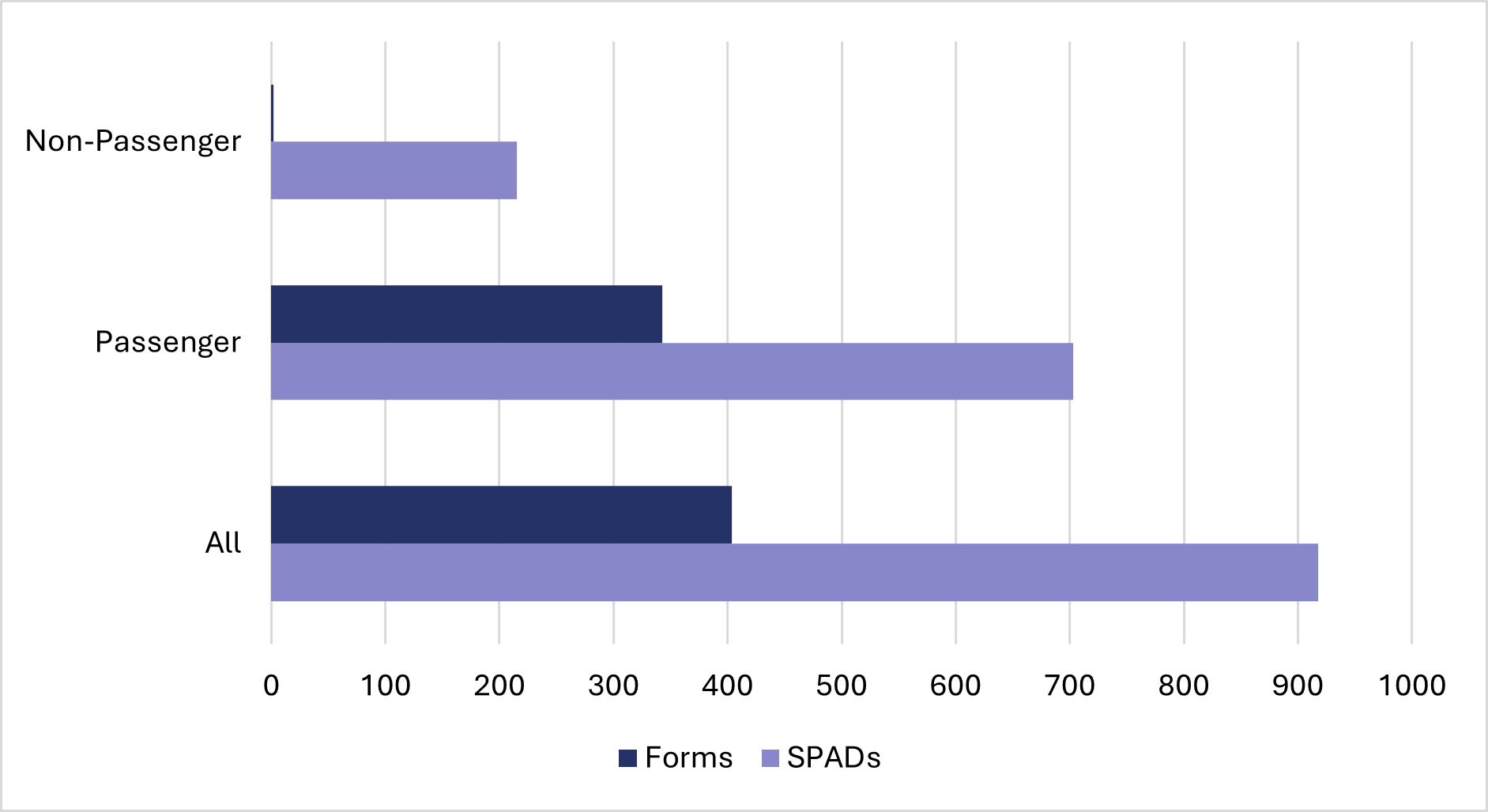
Source: RSSB
| Operator type | Recorded SPADs | Completed forms | Percentage completion |
|---|---|---|---|
| All | 918 | 404 | 44.0% |
| Passenger | 703 | 343 | 48.8% |
| Non-Passenger | 215 | 61 | 28.4% |
Source: RSSB
We continue to support industry investment in ETCS and associated driver training, including use of simulators. ETCS is expected to significantly reduce SPAD and overspeeding risk, though residual risk – such as from low adhesion or equipment failure - remains. The October 2024 collision at Talerddig illustrates this, as one train was unable to stop despite ETCS controls, due to low adhesion conditions.
Overspeeding
We continue to work with the industry in response to recent overspeeding incidents and Rail Accident Investigation Branch (RAIB) recommendations. While ETCS provides a long-term solution, interim measures remain essential to manage current risk levels.
An effective approach to overspeeding requires strong coordination between operators and infrastructure managers, supported by clear speed restriction communication, targeted training, and robust incident investigation processes. Additional inspections are planned through to 2027 to assess how these controls are being applied in practice.
Rolling stock management
We continue to advocate for the consistent application of safety-by-design principles in the procurement of new rolling stock. In some cases, we have seen reductions in engineering safeguards - such as omitting speed supervision systems in replacement fleets – which may compromise long-term risk control.
In freight, wagon condition management is improving, aided by new technologies such as body-worn cameras, which provide valuable assurance and post-incident evidence.
To support better alignment between safety standards and procurement decisions, we are working closely with DfT to ensure early operator involvement in procurement planning.
Progress has also continued on retrofitting central door locking (CDL) to heritage rolling stock. Electromagnetic CDL systems have proven compatible with a range of carriage types, including vacuum-braked vehicles. Of the three operators currently holding exemptions under the Railway Safety Regulations 1999, two are expected to complete retrofitting by year-end, while the third maintains safe operations through reduced speeds and enhanced procedures on a short, single-track section.
Digital safety
As digitalisation accelerates, we are seeing greater industry focus on managing the safety risks associated with software and system changes. While operators show strong board-level commitment to digital safety, further development of a holistic, systems-based approach is needed.
Software failure remains a prominent risk, and industry understanding in this area continues to evolve. Strengthening collaboration across suppliers, manufacturers, and operators is key to building the necessary knowledge and capabilities.
During the year, we presented at Cyber Senate and a Fleet Cyber Security Conference on the need to manage digital safety risks through a complementary Safety Management System approach. As part of the UK Health and Safety Regulators Network, we have led an AI sub-group looking at how AI can be embraced as part of regulatory practice, and how we regulate AI itself. We have also engaged with the Light Rail Safety and Standards Board on their cyber security project for the sector. We have had regular engagement with the DfT, National Cyber Security Centre and Rail Safety and Standards Board (RSSB) on the topic of cyber security and the application of new digital technology. Work will continue into 2025 and 2026, as we build capability.
Workforce health, safety and welfare
Incidents involving violence and aggression towards staff continue to rise, presenting ongoing safety concerns. While these are primarily criminal matters addressed by British Transport Police, we will continue to work with industry and trade unions colleagues to identify safety-based prevention strategies and share good practice.
Fatigue management remains a regulatory priority. RSSB analysis in 2022 found fatigue to be a contributing factor in over 20% of high-risk rail incidents. Our inspections have assessed operators’ fatigue management frameworks, particularly for drivers and controllers, with a focus on shift patterns, overtime controls, and real-time monitoring.
Welfare provision has also been a recurring concern. ASLEF’s Dignity for Drivers Report 2024 highlighted gaps in access to hygiene facilities for staff. While we have seen improvements in some freight locations, other areas require urgent attention.
As a result, the evaluation of welfare provision will form a standard part of all of our inspections during 2025 to 2026. Additionally, we recently convened a cross-industry engagement event to help identify and implement sustainable solutions.
Collaboration with industry groups
We remain closely engaged with a range of key industry forums, including:
- National Freight Safety Group: Our strategic liaison focussed on embedding RM3 industry self-evaluation of management systems. The need to make significant improvements in welfare provision (for example, for lone freight drivers working out-of-hours) has been recognised and a workstream is being developed for a more coordinated industry approach. Our inspection visits to freight yards and depots have prioritised ensuring adequate welfare provision.
- Passenger Operators Safety Forum: Following the closure of Rail Partners, we welcome the continuation of this vital forum under RSSB, ensuring sustained collaboration across the passenger sector.
- People on Trains and Stations Risk Group (PTSRG): We remain actively involved in addressing safety at the platform-train interface. In 2024 to 2025, our engagement focused on managing risks associated with passengers stranded on trains and the dangers of unauthorised self-evacuation onto live lines.
Case Study 1: ORR and Transport Focus Stranded Trains Event – January 2025, Birmingham
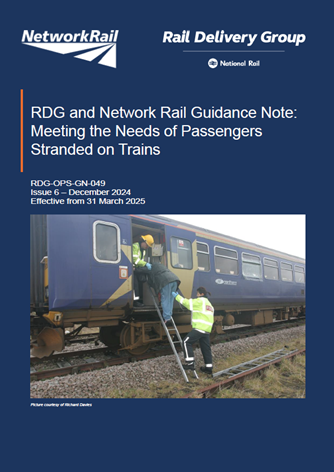
In response to recurring incidents involving passengers stranded on trains, we hosted a cross-industry event in Birmingham in January 2025 in partnership with Transport Focus (the independent transport user watchdog). This event brought together senior leaders from train operators, safety bodies, and other key stakeholders to collaboratively develop solutions focused on improving passenger experience and emergency response.
The event aimed to learn from past incidents and rigorously assess the readiness of current systems, particularly considering the updated GN49 guidance on managing stranded passengers. Discussions centred on enhancing coordination across the rail industry, identifying and supporting vulnerable passengers, empowering frontline staff to respond effectively in dynamic situations, leveraging real-time communication tools including social media, and strengthening resilience through scenario planning and joint exercises.
Key insights from the event highlighted that managing stranded trains is a complex, system-wide challenge requiring coordinated industry action. Culture, capability development, and soft skills training were identified as equally critical as infrastructure improvements. Effective planning must consider multiple variables such as weather conditions, multiple train incidents, and passengers with hidden vulnerabilities. The event also emphasised the importance of localised ownership of responses, mutual aid frameworks, and smarter triage approaches. Innovative tools like HILDA (a system used to detect and alert for potential hazards along the railway), and GSM-enabled messaging platforms were recognised for their potential to enhance forecasting and reassure passengers. Framing the issue in terms of reputational risk and passenger experience helped focus the industry’s efforts on doing the right thing.
The event was widely praised for its focused agenda and impactful case studies, as well as the valuable involvement of Transport Focus. It demonstrated a growing industry commitment to addressing the risks faced by stranded passengers with greater seriousness and urgency.
Building on this momentum, we have set clear expectations for ongoing, collective industry engagement throughout 2025 and beyond to improve the management of stranded train incidents and enhance passenger care.
Case Study 2: Fatigue management
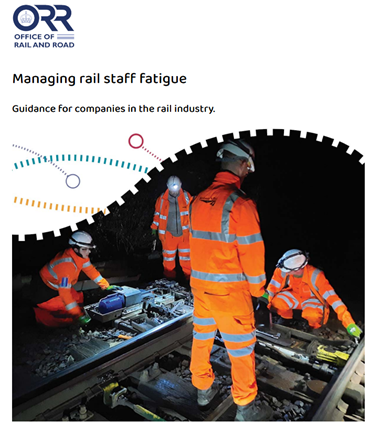 Managing fatigue risk remains a significant challenge for GB’s rail industry. In 2024 to 2025, our Specialist Team focused on specific topics, including fatigue, to drive improvements. After a consultation in early 2024, we published revised fatigue guidance, Managing Rail Staff Fatigue, in a simpler format based on HSE’s ‘Plan, Do, Check, Act’ model. In September, a well-attended launch event introduced the guidance and our expectations that employers maintain suitable and sufficient Fatigue Risk Management Systems (FRMS) or equivalent measures. The event was a valuable opportunity to engage with industry and address questions.
Managing fatigue risk remains a significant challenge for GB’s rail industry. In 2024 to 2025, our Specialist Team focused on specific topics, including fatigue, to drive improvements. After a consultation in early 2024, we published revised fatigue guidance, Managing Rail Staff Fatigue, in a simpler format based on HSE’s ‘Plan, Do, Check, Act’ model. In September, a well-attended launch event introduced the guidance and our expectations that employers maintain suitable and sufficient Fatigue Risk Management Systems (FRMS) or equivalent measures. The event was a valuable opportunity to engage with industry and address questions.
To develop a national overview of fatigue management and legal compliance, we launched a strategic fatigue intervention programme (2024 to 2026) across operators. Early findings show positive industry response to the guidance and inspection programme, with operators implementing improvement plans. While no operator currently has a standalone fatigue policy, there is widespread understanding that fatigue management must be integrated into all parts of the Safety Management System (SMS). We are reassured that all inspected organisations have some level of FRMS and plans to align with the new guidance.
Operators are using the checklist in our Managing Rail Staff Fatigue guidance for gap analysis to assess arrangements and identify actions. A common area needing improvement is training, especially for those designing rosters and managing safety-critical staff. There is growing recognition of the need to move beyond overly tolerant ‘Hidden’ limits, apply our Fatigue Factors in roster design, and acknowledge limitations of the Fatigue Risk Index (FRI). Most organisations lack proactive Key Performance Indicators (KPIs), with monitoring mainly reactive and focused on exceedances and overtime. However, there is positive intent to record actual hours worked rather than just rostered hours going forward.
In conclusion, our updated fatigue guidance has been well received and appears to have initiated efforts to enhance fatigue risk management. Operators acknowledge their approaches are not yet mature, often focusing on the ‘Plan’ and ‘Do’ stages of the management cycle, but there is clear ambition to improve and move away from ‘Hidden’ limits. While challenges remain, increasing awareness and understanding offer cautious optimism that sustainable improvements in fatigue risk management are achievable. We will continue to inspect and monitor progress through 2025 to 2026 and beyond.

